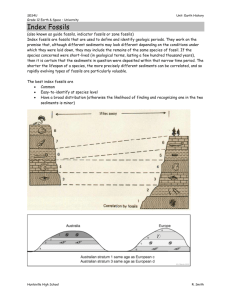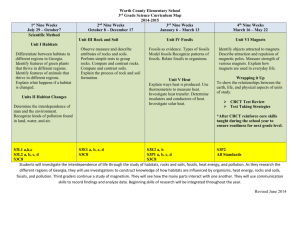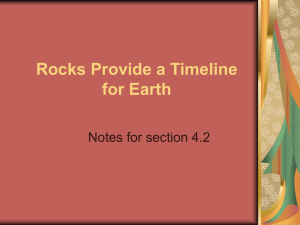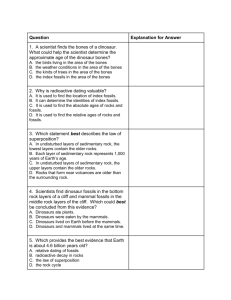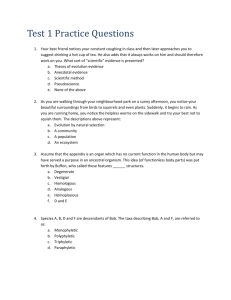Lab 8: Relative and Absolute Geological Dating Lab
advertisement
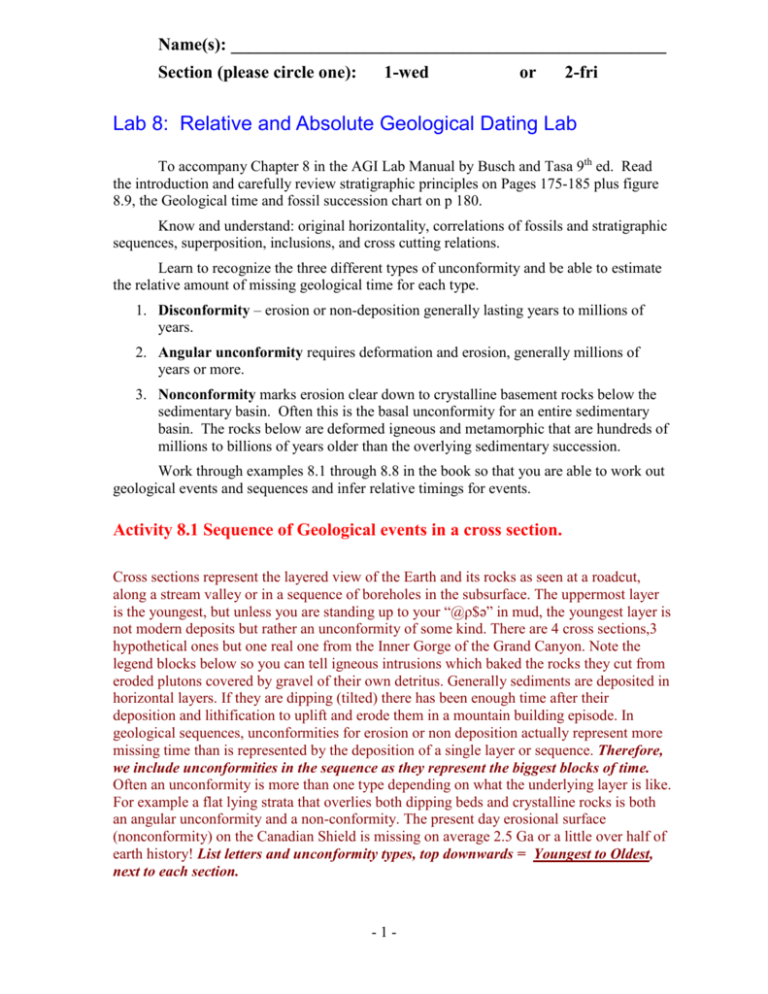
Name(s): _________________________________________________ Section (please circle one): 1-wed or 2-fri Lab 8: Relative and Absolute Geological Dating Lab To accompany Chapter 8 in the AGI Lab Manual by Busch and Tasa 9th ed. Read the introduction and carefully review stratigraphic principles on Pages 175-185 plus figure 8.9, the Geological time and fossil succession chart on p 180. Know and understand: original horizontality, correlations of fossils and stratigraphic sequences, superposition, inclusions, and cross cutting relations. Learn to recognize the three different types of unconformity and be able to estimate the relative amount of missing geological time for each type. 1. Disconformity – erosion or non-deposition generally lasting years to millions of years. 2. Angular unconformity requires deformation and erosion, generally millions of years or more. 3. Nonconformity marks erosion clear down to crystalline basement rocks below the sedimentary basin. Often this is the basal unconformity for an entire sedimentary basin. The rocks below are deformed igneous and metamorphic that are hundreds of millions to billions of years older than the overlying sedimentary succession. Work through examples 8.1 through 8.8 in the book so that you are able to work out geological events and sequences and infer relative timings for events. Activity 8.1 Sequence of Geological events in a cross section. Cross sections represent the layered view of the Earth and its rocks as seen at a roadcut, along a stream valley or in a sequence of boreholes in the subsurface. The uppermost layer is the youngest, but unless you are standing up to your “@ρ$ə” in mud, the youngest layer is not modern deposits but rather an unconformity of some kind. There are 4 cross sections,3 hypothetical ones but one real one from the Inner Gorge of the Grand Canyon. Note the legend blocks below so you can tell igneous intrusions which baked the rocks they cut from eroded plutons covered by gravel of their own detritus. Generally sediments are deposited in horizontal layers. If they are dipping (tilted) there has been enough time after their deposition and lithification to uplift and erode them in a mountain building episode. In geological sequences, unconformities for erosion or non deposition actually represent more missing time than is represented by the deposition of a single layer or sequence. Therefore, we include unconformities in the sequence as they represent the biggest blocks of time. Often an unconformity is more than one type depending on what the underlying layer is like. For example a flat lying strata that overlies both dipping beds and crystalline rocks is both an angular unconformity and a non-conformity. The present day erosional surface (nonconformity) on the Canadian Shield is missing on average 2.5 Ga or a little over half of earth history! List letters and unconformity types, top downwards = Youngest to Oldest, next to each section. -1- Geological Section 1 Inner Gorge Grand Canyon - Geological Section 2 (see Activity 8.6 p 192 for photo) -2- Geological Section 3 Geological Section 4 -3- Activity 8.2 Using Index Fossils to Date Rocks and Geological Events The geological time column (Figure 8.9 above) is divided into Periods (several tens of Ma) with names like Ordovician (for a tribe along the coast of Wales) or Cretaceous (for the age of chalk). The Tertiary Period is further subdivided into: Paleocene, Eocene, Oligocene, Miocene and Pliocene. Fossils are unique impressions or mineral replacements of once living biota. The average lifetime of a species, be it a microscopic species of plankton or a massive mammal, is about 2 Ma. Thus recognizing and telling one fossil species from another gives a pretty well defined interval of time. Groups of closely related animals live longer than individual species. For example there have been horse-shoe crabs since the Lower Paleozoic, but there have been hundreds if not thousands of different species. Index fossils are widespread but short lived and thus are very useful to tell the relative “Geological ages” of different strata, for example Middle Cambrian versus Late Devonian. Marine strata preserve the best fossil records. Before radiometric age dating became possible in the 1960’s, geologists knew that -4- Cambrian was older than Permian, but not by how much or when either of them was in terms of absolute age. Paleontologists use the overlapping and sequential range zones of different groups of fossils. Identifying species with easily distinguished shapes is the key to interpreting relative ages. Now that we have used volcanic ash beds or lavas intercalated with sediments to assign absolute radiomentric ages, we know the Cambrian began 543 million years ago. Be as precise as you can in assigning the Period names such as Early Middle or Late, depending on when the fossil’s range zone starts or ends. Finally, using the absolute age scale along the left edge of the diagram, assign an absolute age to the fossil assemblage pictured. When Paleontologists use many species to constrain this the precision improves down to the level of +/- 0.5Ma in long well studied fossiliferous stratigraphic sequences. Here we are using long lived groups and our precision is less but the general idea is the same. For example, if a stratum contained Shark teeth and the brachiopod Chonetes, we can say it was sometime between Late Devonian and Latest Permian for relative age and between 384 Ma and 255 Ma from the overlap of the 2 range zones for its absolute radiometric age. Examine the photos in the lab manual on p 189 and answer the following questions: • This trilobite is frequently rolled up and has bulbous eye spots • These brachiopods resemble symmetric wings A. Analyse the fossils on p 189 in the top frame and these of the same types. All of these fossils are typically found in fine grained micrites (microcrystalline limestone mud). 1. What are the names of the 2 index fossils ______________ & __________. To what 2 groups of marine invertebrates do they belong? ____________ & _______________. (4) -5- 2. Based on the overlap of the range zones of these 2 index fossils, their strata belong to the (circle one) Early Middle Late ________________________ (geological time period). (2) 3. What is the absolute age range, from the oldest possible age to the youngest possible age when both of these index fossils coexisted? ____________ Ma to _____________ Ma (2) Straight cephalopod (walking stick rock) Fossil oysters (devil’s toenail) B. Analyse the fossils on p 189 in the middle frame and these images above of the same types. Unlike what the book says these are never found in Ohio outside of museums! These fossils are typically found in both limestones and detrital sandstones across much of the world including parts of Canada from Vancouver Island to Saskatchewan. 1. What are the names of the 2 index fossils ______________ & __________. (2) 2. Based on the overlap of the range zones of these 2 index fossils, their strata belong to the (circle one) Early Middle Late ________________________ (geological time period). (2) 3. What is the absolute age range, from the oldest possible age to the youngest possible age when both of these index fossils coexisted? ____________ Ma to _____________ Ma (2) -6- • 2 different contemporaneous brachiopods with • 2 images of a trilobite from the same strata C. Analyse the fossils on p 189 in the top frame and these of the same types. All of these fossils are typically found in fine grained micrites (microcrystalline limestone mud). 1. What are the names of the 2 index fossils ______________ & __________. (2) 2. Based on the overlap of the range zones of these 2 index fossils, their strata belong to the (circle one) Early Middle Late ________________________ (geological time period). (2) 3. What is the absolute age range, from the oldest possible age to the youngest possible age when both of these index fossils coexisted? ____________ Ma to _____________ Ma (2) -7- D. Using Figure 8.9 to identify the fossils and their relative ages, examine the cross section figure 8.2 above and answer the following questions. 1. There is a disconformity between beds _________ and _______ (2) 2. In sedimentary geology, a “system” is the bed or succession of beds deposited during a particular time interval. At the very least, what system is missing from cross section 8.2? (Period) _________. (1) 3. With fossils, we do not know from just one occurrence whether we have the very earliest occurrence of a fossil or the very latest, or somewhere in between. This introduces some error or uncertainty in figuring the interval of missing time. Assuming the lower trilobite was the very first of its kind and the upper trilobite was the very last of its kind, what is the maximum amount of time missing: in relative ages from Early Middle Late ______________ to Early Middle Late ______________. (4) 4. The uncertainty is that these fossils might have been the last and first of their kinds respectively. What is the maximum and minimum age missing between these 2 beds in absolute radiometric time? Minimum _____________ Ma and Maximum _____________ Ma (4) E. Examine Figure 8.3 above and note that the lower strata are dipping, while the upper strata are flatlying. 1. The bold black wavy line labeled E is a/an: Nonconformity Angular Unconformity Disconformity (1) 2. Check the fossil ages on figure 8.9 and note that the lower dipping beds are Paleozoic while the upper flat lying beds are Tertiary. At the very least 2 important geological processes occurred during the missing time represented by E. What were they? ___________ & _____________ (2) Activity 8.3 Absolute Dating Rocks and Fossils using radioactive decay pairs. -8- The absolute time scale is based on long lived radioactive parent elements (isotopes) and their daughter elements (isotopes). A small proportion of the isotopes of certain elements are intrinsically unstable and prone to radioactive decay. This occurs at a fixed rate for each isotope pair and is expressed as half lives, where half of the initial parent isotope decays in 1 half life. Read the instructions on Absolute Dating p 181-183 and answer the following questions. • Note the relative age of the Fagopsis leaf & • Obtain the Absolute age from the Zircon A. Mass spectrometry on the zircon from the sill gave 98.9% parent 235U and 1.1% 207Pb. Find this value on the decay curve. Geochronologists quickly calculate how far they are along the decay curve by diving the % of the Parent by the % of the daughter to get a simple ratio. To begin with this ratio is infinite. After 1 half life it is 1.0 while after 2 half lives it is 0.333 etc. 1. Compute the value of the Parent/Daughter ratio in the Zircon? ____________________ (3) 2. About how many half lives have elapsed since the sill emplaced? ______________ (2) 3. What is the half life of the parent isotope 235U? ___________________ Ma (1) 4. What is the absolute age of the sill based on the crystallization age of the zircon crystals? To do this, multiply the half life of the parent isotope by the number of half lives elapsed. Show your calculations. (3) 5. What is the relative geological age (Period) for the sedimentary rocks below the lava flow? _________________________________________________________________________ (2) -9- 6. What is the minimum absolute radiometric age the shale just below the sill? _________________________________________________________________________ (2) 7. Explain when the sill became faulted and eroded and how you know this? _________________________________________________________________________ (2) 8. List the sequence of events youngest to oldest for this strip mine outcrop from New Mexico. Use the names of the relative ages, the date for the absolute age, the flow, the shale and sandstone and coal beds and the unconformity on top. (7) B. 1. Based on equal proportions of daughter 206Pb and parent 238U in the oldest meteorites, what is the numerical value of their parent/daughter ratio _____________how many half lives have elapsed since their formation? ________________________________________________________ (2) 2. How many years is this for the age of the Earth? ________________________________ (2) & during what Eon did Earth first form? ___________________________________ (1) C.1. A buried (not modern) peat bed has 6.000 % 14C parent remaining and 94.000 % 14N daughter. Calculate the parent/daughter ratio for the peat bed to 4 decimal places ______________? (3) 2. How many half lives have elapsed since the peat was deposited________? (1) 3. What is absolute age of the Peat bed in years? __________________. (3) 4. What geological Period does this peat bed belong to? ________________ (1) 5. Why must you avoid contamination of the peat by either younger living plant roots or older dead carbon such as limestone or oil spills? ________________________________________ ___________________________________________________________________ (2) 6. What are the oldest deposits that can be dated by the radiocarbon method? _________ ______________________________________________________________________ (2) 7. Explain why this is so: (2) - 10 - D. Zircon (ZrSiO4) is a trace mineral in most igneous rocks, making up less than a few percent. It forms as the magma cools and solidifies. From this time onwards the small contaminant of Uranium decays to lead according to the radioactive decay law and the half life for each P/D isotope pair. From this we can date the cooling age of magmatic rocks. 1. As you walk on a modern beach here like Dallas Road or Island View, the sand will contain some small amount of zircons. Could zircon crystals in such modern beach sands be used to date the time of sedimentary deposition (like the last storm)? Circle one: Yes No (1) Explain why? • Zoned metamorphic rims as overgrowths on an original igneous core • The igneous core is metamict (radiation damaged) 2. For Precambrian rocks (up to billions of years ago, before fossils) the only way to date events line intrusions or metamorphism is by radiometric dating using appropriate minerals and isotope pairs. While igneous crystals are simple and unzoned, metamorphic crystals contain an original igneous core and one or more rims for subsequent metamorphic events. With a special tool called SHRIMP, basically a laser beam aimed through a microscope and hooked up to a mass spectrometer, zircons can now be dated one layer at a time, like peeling an onion! In this case could zircon crystals in a very old Precambrian metasediment (metamorphosed sedimentary rock ) be used to date the time of deposition of that sediment? (circle one): Yes No Explain why? (2) - 11 - 2. When geologists need to date minerals or rocks they need to know certain things before attempting to do this. Now that you have done some relative and absolute dating, what 3 geological rules should be followed in attempting to date any rock using the isotopes in one of its minerals? (3) _______________________________________________________________________________ E. An E-bay special offers an “authentic dinosaur bone” confirmed by radiocarbon dating to be 400 Ma. What 2 things are wrong with the “scientific claims” the seller makes? (2) ______________________________________________________________________________ - 12 -

